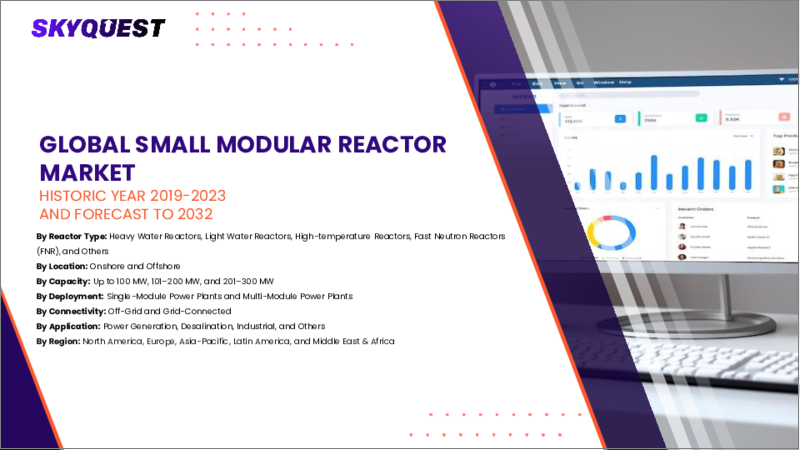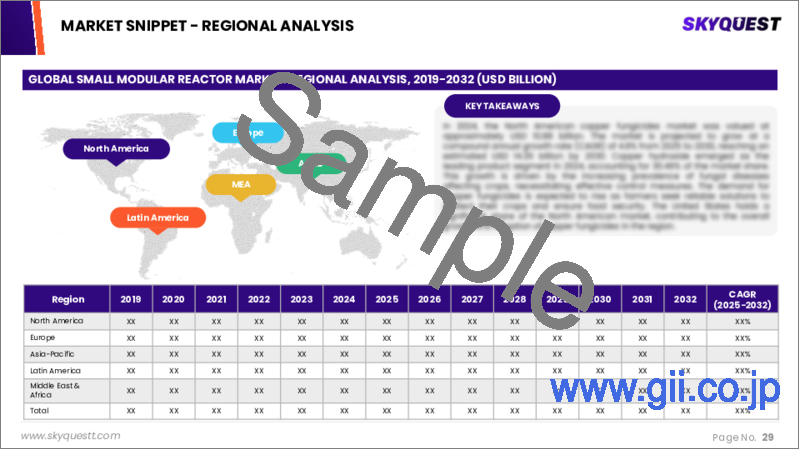|
|
市場調査レポート
商品コード
1670216
小型モジュール炉の市場規模、シェア、成長分析:原子炉タイプ別、展開別、容量別、用途別、地域別 - 産業予測 2025~2032年Small Modular Reactor Market Size, Share, and Growth Analysis, By Reactor Type (Light Water Reactors (LWR), Heavy Water Reactors (HWR)), By Deployment (Onshore, Offshore), By Capacity, By Application, By Region - Industry Forecast 2025-2032 |
||||||
|
|||||||
| 小型モジュール炉の市場規模、シェア、成長分析:原子炉タイプ別、展開別、容量別、用途別、地域別 - 産業予測 2025~2032年 |
|
出版日: 2025年02月28日
発行: SkyQuest
ページ情報: 英文 196 Pages
納期: 3~5営業日
|
全表示
- 概要
- 目次
小型モジュール炉市場規模は2023年に68億9,000万米ドルと評価され、2024年の75億米ドルから2032年には148億4,000万米ドルに成長し、予測期間(2025-2032年)のCAGRは8.9%で成長する見通しです。
小型モジュール炉(SMR)市場は、環境に対する関心の高まりとカーボンニュートラルの世界の推進により、大きな成長を遂げています。SMRは、従来の化石燃料発電に代わる持続可能な発電方式であり、二酸化炭素排出量の削減に重点を置いています。技術の進歩と政府による規制の後押しが、この市場の拡大にさらに拍車をかけています。SMRの設計は製造と組み立てを単純化できるため、大型の原子炉に比べて建設コストと工期を削減できます。環境への影響も少なく、水の使用量や廃棄物の発生量も少ないため、さまざまな用途で理想的なエネルギー源として位置づけられています。さらに、エネルギー集約型産業における需要の高まりは生産性と経済成長を促進し、原子力部門における革新は雇用創出と共同投資を重視し、SMRをエネルギーの将来における重要な企業として確固たるものにしています。
目次
イントロダクション
- 調査の目的
- 調査範囲
- 定義
調査手法
- 情報調達
- 二次と一次データの方法
- 市場規模予測
- 市場の前提条件と制限
エグゼクティブサマリー
- 世界市場の見通し
- 供給と需要の動向分析
- セグメント別機会分析
市場力学と見通し
- 市場概要
- 市場規模
- 市場力学
- 促進要因と機会
- 抑制要因と課題
- ポーターの分析
主な市場の考察
- 重要成功要因
- 競合の程度
- 主な投資機会
- 市場エコシステム
- 市場の魅力指数(2024年)
- PESTEL分析
- マクロ経済指標
- バリューチェーン分析
- 価格分析
- ケーススタディ
小型モジュール炉市場規模:原子炉タイプ別& CAGR(2025-2032)
- 市場概要
- 軽水炉(LWR)
- 重水炉(HWR)
- 高温炉(HTR)
- 高速中性子炉(FNR)
- 溶融塩炉(MSR)
小型モジュール炉市場規模:展開別& CAGR(2025-2032)
- 市場概要
- オンショア
- オフショア
小型モジュール炉市場規模:容量別& CAGR(2025-2032)
- 市場概要
- 最大100MW
- 101MWから300MW
小型モジュール炉市場規模:用途別& CAGR(2025-2032)
- 市場概要
- 発電
- 淡水化
- プロセス熱
- 産業
小型モジュール炉市場規模:地域別& CAGR(2025-2032)
- 北米
- 米国
- カナダ
- 欧州
- ドイツ
- スペイン
- フランス
- 英国
- イタリア
- その他欧州地域
- アジア太平洋地域
- 中国
- インド
- 日本
- 韓国
- その他アジア太平洋地域
- ラテンアメリカ
- ブラジル
- その他ラテンアメリカ地域
- 中東・アフリカ
- GCC諸国
- 南アフリカ
- その他中東・アフリカ
競合情報
- 上位5社の比較
- 主要企業の市場ポジショニング(2024年)
- 主な市場企業が採用した戦略
- 最近の市場動向
- 企業の市場シェア分析(2024年)
- 主要企業の企業プロファイル
- 企業の詳細
- 製品ポートフォリオ分析
- 企業のセグメント別シェア分析
- 収益の前年比比較(2022-2024)
主要企業プロファイル
- NuScale Power(USA)
- Holtec International(USA)
- GE Hitachi Nuclear Energy(USA)
- Rosatom(Russia)
- Westinghouse Electric Company(USA)
- TerraPower(USA)
- General Atomics(USA)
- X-energy(USA)
- Rolls-Royce SMR(UK)
- China National Nuclear Corporation(CNNC)(China)
- Korea Atomic Energy Research Institute(KAERI)(South Korea)
- Canadian Nuclear Laboratories(CNL)(Canada)
- Oklo Inc.(USA)
- Ultra Safe Nuclear Corporation(USA)
- Idaho National Laboratory(USA)
- Moltex Energy(UK)
- U-Battery Developments(UK)
- Seaborg Technologies(Denmark)
- ThorCon Power(USA)
結論と提言
Small Modular Reactor Market size was valued at USD 6.89 billion in 2023 and is poised to grow from USD 7.5 billion in 2024 to USD 14.84 billion by 2032, growing at a CAGR of 8.9% during the forecast period (2025-2032).
The small modular reactor (SMR) market is experiencing significant growth, driven by rising environmental concerns and the global push for carbon neutrality. SMRs present a sustainable alternative to traditional fossil fuel power generation, focusing on reducing carbon emissions. Technological advancements and supportive government regulations have further fueled this market expansion. SMRs' design allows for simpler manufacturing and assembly, leading to lower construction costs and timelines compared to larger reactors, while also enhancing safety through advanced features such as passive cooling. Their minimal environmental impact, low water usage, and waste generation position them as ideal energy sources for various applications. Additionally, rising demand in energy-intensive industries promotes productivity and economic growth, while innovations in the nuclear sector emphasize job creation and collaborative investments, solidifying SMRs as a key player in the future of energy.
Top-down and bottom-up approaches were used to estimate and validate the size of the Small Modular Reactor market and to estimate the size of various other dependent submarkets. The research methodology used to estimate the market size includes the following details: The key players in the market were identified through secondary research, and their market shares in the respective regions were determined through primary and secondary research. This entire procedure includes the study of the annual and financial reports of the top market players and extensive interviews for key insights from industry leaders such as CEOs, VPs, directors, and marketing executives. All percentage shares split, and breakdowns were determined using secondary sources and verified through Primary sources. All possible parameters that affect the markets covered in this research study have been accounted for, viewed in extensive detail, verified through primary research, and analyzed to get the final quantitative and qualitative data.
Small Modular Reactor Market Segments Analysis
Global Small Modular Reactor Market is segmented by Reactor Type, Deployment, Capacity, Application and region. Based on Reactor Type, the market is segmented into Light Water Reactors (LWR), Heavy Water Reactors (HWR), High-Temperature Reactors (HTR), Fast Neutron Reactors (FNR) and Molten Salt Reactors (MSR). Based on Deployment, the market is segmented into Onshore and Offshore. Based on Capacity, the market is segmented into Up to 100 MW and 101 MW to 300 MW. Based on Application, the market is segmented into Power Generation, Desalination, Process Heat and Industrial. Based on region, the market is segmented into North America, Europe, Asia Pacific, Latin America and Middle East & Africa.
Driver of the Small Modular Reactor Market
The Small Modular Reactor (SMR) market is being significantly driven by the rising demand for electricity in both residential and industrial sectors, compelling governments to focus on sustainable energy solutions rather than traditional power generation methods, thereby minimizing their carbon emissions. The widespread electrification of connected devices, transportation systems, and essential services further amplifies this demand for reliable power sources. Consequently, the appeal of Small Modular Reactors has grown, as they provide a cleaner energy alternative with lower carbon emissions, positioning them as a viable solution to meet the escalating electricity needs while supporting environmental sustainability goals.
Restraints in the Small Modular Reactor Market
The Small Modular Reactor (SMR) market faces several challenges that restrain its growth. While SMRs possess multiple benefits such as built-in stability mechanisms, modular configurations, and advanced design attributes suitable for various applications, including heating, desalination, cogeneration, and chemical processing, they also entail complex design and manufacturing processes. These intricacies necessitate the use of specialized components and the integration of advanced technologies, ultimately raising production costs. Furthermore, concerns regarding safety and stringent regulatory requirements can further exacerbate financial pressures on stakeholders, hindering the widespread adoption and commercialization of SMRs in the energy sector.
Market Trends of the Small Modular Reactor Market
The Small Modular Reactor (SMR) market is witnessing a significant upward trend fueled by an increasing demand for high flexibility and reliability in nuclear energy. As nations strive for a cleaner and more sustainable energy landscape, SMRs emerge as a pivotal solution, offering innovative designs that can be deployed incrementally and efficiently. With advancements in technology leading to reduced costs and enhanced safety features, SMRs are gaining traction amidst a backdrop of transformative clean energy innovations, including solar and wind. Their ability to integrate seamlessly into diverse energy systems positions SMRs as a crucial component in achieving global decarbonization targets and fostering economic resilience.
Table of Contents
Introduction
- Objectives of the Study
- Scope of the Report
- Definitions
Research Methodology
- Information Procurement
- Secondary & Primary Data Methods
- Market Size Estimation
- Market Assumptions & Limitations
Executive Summary
- Global Market Outlook
- Supply & Demand Trend Analysis
- Segmental Opportunity Analysis
Market Dynamics & Outlook
- Market Overview
- Market Size
- Market Dynamics
- Drivers & Opportunities
- Restraints & Challenges
- Porters Analysis
- Competitive rivalry
- Threat of substitute
- Bargaining power of buyers
- Threat of new entrants
- Bargaining power of suppliers
Key Market Insights
- Key Success Factors
- Degree of Competition
- Top Investment Pockets
- Market Ecosystem
- Market Attractiveness Index, 2024
- PESTEL Analysis
- Macro-Economic Indicators
- Value Chain Analysis
- Pricing Analysis
- Case Studies
Global Small Modular Reactor Market Size by Reactor Type & CAGR (2025-2032)
- Market Overview
- Light Water Reactors (LWR)
- Heavy Water Reactors (HWR)
- High-Temperature Reactors (HTR)
- Fast Neutron Reactors (FNR)
- Molten Salt Reactors (MSR)
Global Small Modular Reactor Market Size by Deployment & CAGR (2025-2032)
- Market Overview
- Onshore
- Offshore
Global Small Modular Reactor Market Size by Capacity & CAGR (2025-2032)
- Market Overview
- Up to 100 MW
- 101 MW to 300 MW
Global Small Modular Reactor Market Size by Application & CAGR (2025-2032)
- Market Overview
- Power Generation
- Desalination
- Process Heat
- Industrial
Global Small Modular Reactor Market Size & CAGR (2025-2032)
- North America (Reactor Type, Deployment, Capacity, Application)
- US
- Canada
- Europe (Reactor Type, Deployment, Capacity, Application)
- Germany
- Spain
- France
- UK
- Italy
- Rest of Europe
- Asia Pacific (Reactor Type, Deployment, Capacity, Application)
- China
- India
- Japan
- South Korea
- Rest of Asia-Pacific
- Latin America (Reactor Type, Deployment, Capacity, Application)
- Brazil
- Rest of Latin America
- Middle East & Africa (Reactor Type, Deployment, Capacity, Application)
- GCC Countries
- South Africa
- Rest of Middle East & Africa
Competitive Intelligence
- Top 5 Player Comparison
- Market Positioning of Key Players, 2024
- Strategies Adopted by Key Market Players
- Recent Developments in the Market
- Company Market Share Analysis, 2024
- Company Profiles of All Key Players
- Company Details
- Product Portfolio Analysis
- Company's Segmental Share Analysis
- Revenue Y-O-Y Comparison (2022-2024)
Key Company Profiles
- NuScale Power (USA)
- Company Overview
- Business Segment Overview
- Financial Updates
- Key Developments
- Holtec International (USA)
- Company Overview
- Business Segment Overview
- Financial Updates
- Key Developments
- GE Hitachi Nuclear Energy (USA)
- Company Overview
- Business Segment Overview
- Financial Updates
- Key Developments
- Rosatom (Russia)
- Company Overview
- Business Segment Overview
- Financial Updates
- Key Developments
- Westinghouse Electric Company (USA)
- Company Overview
- Business Segment Overview
- Financial Updates
- Key Developments
- TerraPower (USA)
- Company Overview
- Business Segment Overview
- Financial Updates
- Key Developments
- General Atomics (USA)
- Company Overview
- Business Segment Overview
- Financial Updates
- Key Developments
- X-energy (USA)
- Company Overview
- Business Segment Overview
- Financial Updates
- Key Developments
- Rolls-Royce SMR (UK)
- Company Overview
- Business Segment Overview
- Financial Updates
- Key Developments
- China National Nuclear Corporation (CNNC) (China)
- Company Overview
- Business Segment Overview
- Financial Updates
- Key Developments
- Korea Atomic Energy Research Institute (KAERI) (South Korea)
- Company Overview
- Business Segment Overview
- Financial Updates
- Key Developments
- Canadian Nuclear Laboratories (CNL) (Canada)
- Company Overview
- Business Segment Overview
- Financial Updates
- Key Developments
- Oklo Inc. (USA)
- Company Overview
- Business Segment Overview
- Financial Updates
- Key Developments
- Ultra Safe Nuclear Corporation (USA)
- Company Overview
- Business Segment Overview
- Financial Updates
- Key Developments
- Idaho National Laboratory (USA)
- Company Overview
- Business Segment Overview
- Financial Updates
- Key Developments
- Moltex Energy (UK)
- Company Overview
- Business Segment Overview
- Financial Updates
- Key Developments
- U-Battery Developments (UK)
- Company Overview
- Business Segment Overview
- Financial Updates
- Key Developments
- Seaborg Technologies (Denmark)
- Company Overview
- Business Segment Overview
- Financial Updates
- Key Developments
- ThorCon Power (USA)
- Company Overview
- Business Segment Overview
- Financial Updates
- Key Developments





